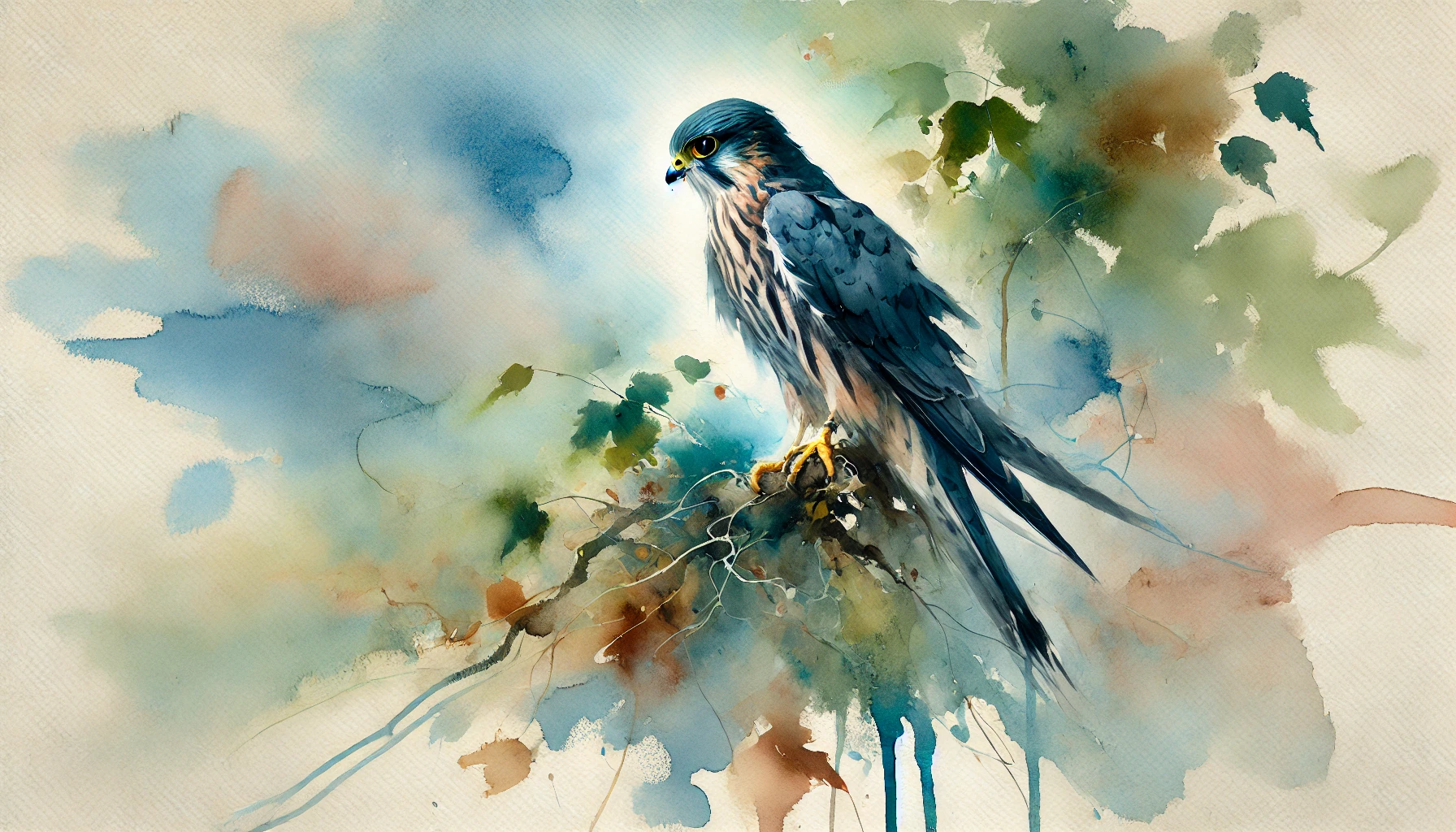Falcons are a bird of prey, typically known for being capable hunters of great speed and agility, being some of the fastest animals in the world; the peregrine falcon in particular is capable of reaching speeds of up to 389km/h.
In certain habitats they are an umbrella species meaning its conservation benefits many other living organisms within the ecosystems in which they live.
Merlin (Falco columbarius)
The Merlin is a small falcon found across Europe and Asia. Eurasian and North American populations have been genetically distinct for over a million years. In Europe, the Merlin is represented by several subspecies, including Falco columbarius/aesalon aesalon, which inhabits northern Eurasia, and Falco columbarius/aesalon subaesalon, found in Iceland and the Faroe Islands. These birds are typically migratory, moving to southern Europe and North Africa for winter.
Merlins prefer open habitats such as moorlands, shrublands, and taiga forests. They are agile hunters, primarily feeding on small birds such as larks and pipits
In Europe, they are known to roost communally with other raptors like hen harriers during winter.
The conservation status of the Merlin is currently of least concern.
Lesser Kestrel (Falco naumanni)
The Lesser Kestrel is a small falcon widespread across southern Europe, the Iberian Peninsula, and parts of Asia and Africa. In Spain, its population declined drastically in the 20th century but has since recovered due to conservation efforts, including artificial nesting sites.
Lesser Kestrels are smaller than their close relative, the common kestrel. Males have blue-grey heads and reddish-brown backs, while females are brown with streaking. They feed mainly on insects like grasshoppers, though they will also take small birds and mammals. Lesser Kestrels are highly social, nesting in colonies and migrating to Africa for winter.
The conservation status of the Lesser Kestral is currently of least concern.
Peregrine Falcon (Falco peregrinus)
The Peregrine Falcon is one of the most widespread birds of prey, found almost worldwide. Known for its incredible diving speed of over 300 km/h, the Peregrine is the fastest animal on Earth. It is a large falcon with blue-grey plumage and a distinctive black “moustache.”
Peregrines primarily hunt medium-sized birds such as pigeons and ducks. They nest on cliffs or tall human-made structures. The species faced population declines due to pesticide use in the mid-20th century, but since the banning of DDT, populations have recovered.
The conservation status of the Peregrine Falcon is currently of least concern.
Eurasian Hobby (Falco subbuteo)
The Eurasian Hobby is a small, slender falcon found throughout Europe and Asia. It is a long-distance migratory bird, spending summers in Europe and winters in Africa. In Spain, it can be seen in regions like the Balearic Islands during summer.
Hobbies are skilled aerial hunters, catching prey such as dragonflies, swifts, and bats. They nest in old nests made by other birds, typically laying 2-4 eggs. Their long, pointed wings give them a swift-like appearance in flight. There are two subspecies, with Falco subbuteo subbuteo being the most common across the Palearctic.
The conservation status of the Eurasian Hobby is currently of least concern.
Common Kestrel (Falco tinnunculus)
The Common Kestrel is found across Europe, Africa, and Asia. It is slightly larger than the Lesser Kestrel, with males displaying a blue-grey head and reddish wings spotted with black. The common kestrel is a versatile hunter, hovering over fields to spot prey such as small mammals, reptiles, and insects.
This species breeds in a variety of locations, including cliffs, trees, and buildings, often reusing old nests. It is known for its adaptability and is commonly seen in both rural and urban environments. Eleven subspecies are recognized, including Falco tinnunculus tinnunculus, which is common throughout Europe.
The conservation status of the Common Kestral is currently of least concern.
Summary of the Falcons in Galicia
In Galicia, several of these falcon species can be found, particularly during their migratory periods or in suitable habitats:
- Merlin (Falco columbarius): The Merlin is a regular winter visitor in Galicia, migrating from northern Europe to spend the colder months in southern regions. It is often spotted in open areas like moorlands and coastal scrublands, where it hunts small birds.
- Lesser Kestrel (Falco naumanni): The Lesser Kestral can be seen in Galicia but very rarely. Its presence is more concentrated in southern Spain and other Mediterranean regions.
- Peregrine Falcon (Falco peregrinus): Peregrine Falcons breed in parts of Galicia, particularly along the coastlines and rocky cliffs, where they find suitable nesting sites. They are also present throughout the year, taking advantage of the region’s birdlife, especially near coastal and wetland areas.
- Eurasian Hobby (Falco subbuteo): The Eurasian Hobby is a summer visitor to Galicia, typically arriving in the warmer months before migrating to Africa for the winter. It can be seen in open areas with scattered trees, hunting insects and small birds in flight.
- Common Kestrel (Falco tinnunculus): The Common Kestrel is a year-round resident in Galicia, frequently seen hovering over farmlands, grasslands, and even urban areas. Its adaptability allows it to thrive in a variety of environments across the region.
Red Book of Birds in Spain
Fortunately, the Falcons found in Galicia are have a conservation status of least concern. However, SEO Birdlife has published a Red Book of the species that are endangered in Spain.
And while they are not endangered, they do sometimes prey on other birds. Even with a basic understanding of ecology, it’s clear that losing a food source could have long-term effects on the species and ecosystems they inhabit.
